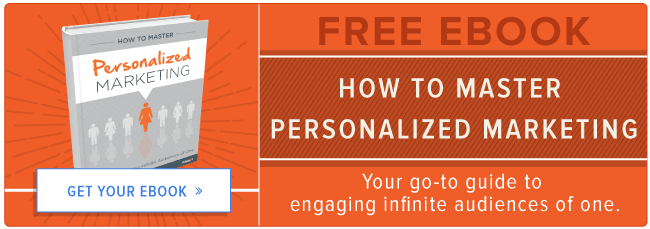 Personalized marketing is more than just a buzzword you should use when trying to fit in at networking events. Gone are the days of the generic blast email and one-size-fits-all website. Today, three out of four companies personalize their marketing efforts, most commonly across websites and emails.
Personalized marketing is more than just a buzzword you should use when trying to fit in at networking events. Gone are the days of the generic blast email and one-size-fits-all website. Today, three out of four companies personalize their marketing efforts, most commonly across websites and emails.
And it’s what consumers want. Overwhelmingly, customer engagement is cited as the top reason for prioritizing personalization in marketing. It makes sense, really — why wouldn’t I prefer content that speaks directly to me and my interests? Maybe I’m skewed as a marketer, but if you’ve taken the time and energy to learn a bit more about me, I’m more likely to take the time to listen to your pitch and probably more likely to make a purchase.
When you know more about your audience, you can present them with customized marketing, all targeted through the channels they engage in most. What could you do with more, enriched information about your prospects and customers? Here are some ideas for different types of information you can gather about your audience, and how you can use them to personalize your marketing efforts. While not all of these may be applicable to your business and your audience, they can give you a jumping-off point for new personalization ideas.
Demographics and Interests
1) The Basics
Job title, age, gender, marital status, education level … these are some of the very basic pieces information you may already be collecting that can easily be used to offer targeted content to your audience. For example, someone who is married may be interested in a two-for-one vacation offer via email.
2) Life Events
These refer to major life changes, like purchasing a first home, moving to a new area, becoming a parent for the first time, etc. Be thoughtful about what might be on someone’s mind as they experience these events and provide them with related content and offers. Someone who just purchased a new house, for example, may be very interested in a blog post on the top three things to know about homeowner’s insurance.
3) Life Stage
These attributes indicate things like presence of children in the home, whether someone owns or rents, if an individual is a business owner and more. Life stage is another attribute where you can assess what could be on someone’s mind and provide them with the right content at the right time. A great example is offering a discount on dorm room essentials to the parents of students about to go off to college.
4) Channel Receptivity
This attribute answers the question “How receptive is someone to marketing programs in different channels?” For example, if you know certain people have engaged with you in the past via email, email campaigns could be a more appropriate channel to reach those individuals rather than through Facebook.
Website Activities
5) Recent Purchases
Understanding someone’s shopping habits and particularly what someone most recently purchased from you can be especially powerful for retailers looking to cross-sell their customers. For example, if someone recently purchased one type of cosmetic, you could surface a related product that other similar customers have purchased in the past.
6) Site Arrival
How did your site visitors arrive? Was it a referral through social media? A Google search? A click in an email campaign? Knowing this can help you target visitors with content most relevant to what they are seeking, such as creating a custom call-to-action to share a piece of content based on the social network someone’s coming from.
7) Abandoned Carts
If you’re an ecommerce business, you can find out a lot about someone based on what they considered purchasing from your online store. Use abandoned shopping cart information to remarket those forgotten items to them via display ads or email campaigns, perhaps even offering a discount they can’t refuse.
8) Types of Content Being Viewed
Keeping tabs on the types of pages your website visitors are engaging in can tell you more about what stage in the buying cycle they are in. This helps you target them with more relevant target to push them further through the funnel. For example, someone looking at your pricing pages is more likely closer to a purchase than someone who only downloaded a whitepaper.
9) Topics of Content Being Viewed
Are your visitors seeking out specific content or topics within your site? This information can be a great way to personalize with relevant content. For example, if someone just downloaded an ebook on Facebook marketing, they probably would love more information about Facebook.
10) Blog or Newsletter Subscriptions
If someone signs up to receive your blog’s updates or your email newsletter, you can take advantage of preference centers to find out what topics your subscribers might want to learn more about. Additionally, if someone subscribes for your content, that means they are likely very engaged with your brand, and may be open to learning about the products and services you offer.
11) Device and Location Access
Knowing whether someone accesses your website on their mobile phone or their desktop computer can help you deliver the right form of content for the size of the screen. Additionally, knowing where location-wise your visitors are when looking at your site can be an opportunity to regionalize content you display.
12) Guest vs. Logged In
If you have a member or customer portal that visitors can log in to, you can present content and offers that are targeted to that status. Another way to use this information is through frequency of log in — someone who logs in to your site regularly may want to see different content each time.
What other attributes are you personalizing offer based on? How are you gathering this information? Tell us in the comments!
![]()




